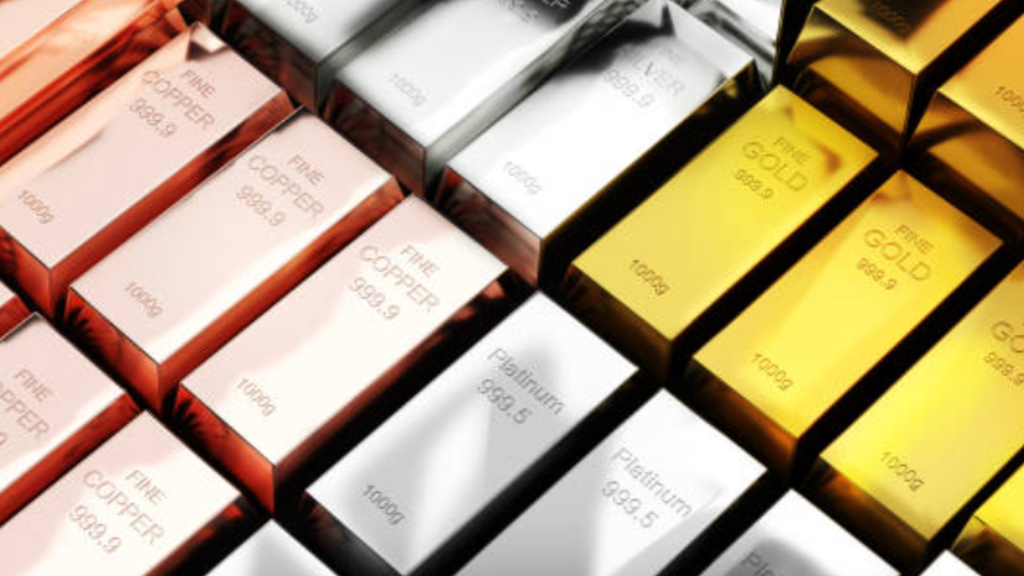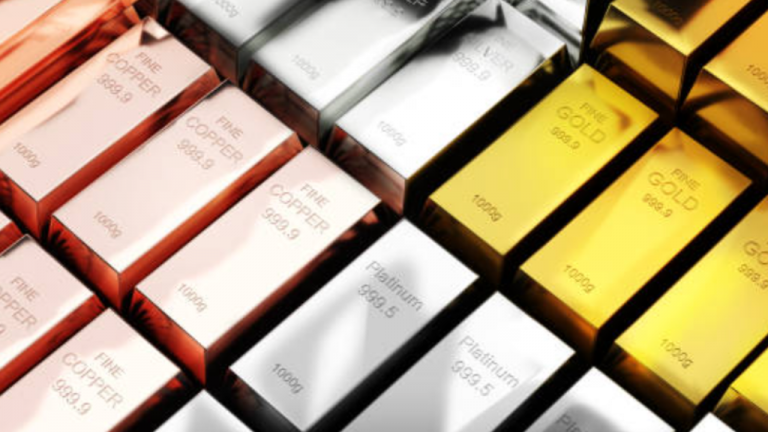
The abundance of a substance determines its monetary worth. Precious metals are more valuable when they are less “accessible.” Various chemistry-based factors determine the value of imports. Valuable metals include iridium, ruthenium, rhodium, palladium, osmium, platinum, silver, and gold.
When asked which is the most valuable precious metal in the world, you may quickly think of gold or platinum. The two metals are high on the list, but one is more affordable than the other.
Typically, the price of precious metal is determined by its availability, demand, qualities, and extraction method. Some of these are influenced by other variables, such as the impact of new technology on demand for a particular metal or the effect of political unrest or conflict on its supply.
Table of Contents
1. Rhodium
After a price increase of more than 30 percent this year, rhodium is one of the hottest trades, despite being relatively unfamiliar to the general public. The price of rhodium peaked in 2008 at more than $10,000 per troy ounce (oz) before plummeting precipitously, but the metal is presently trading above that 2008 top due to a surge in demand from the automobile sector. Sourcian is a dedicated platform for the recommendation of the best manufacturers. Your sourcing journey starts right here at sourcian.
Rhodium is utilized in catalytic converters, a component of automotive exhaust systems that minimize harmful gas emissions and pollutants. According to S&P Global Plats, about 80% of rhodium and palladium demand originates from the global automobile industry. Fortunately for South Africa, over 80 percent of the world’s rhodium is extracted within its borders.
Its scarcity contributes to the metal’s price increase. Annual rhodium output is around 30 tonnes; for comparison, gold miners extract between 2,500 and 3,000 tonnes of the valuable metal each year. Rhodium also benefited from the Volkswagen emissions scandal, often known as Dieselgate, which shook the automobile sector in 2015. Platinum group metals (PGM) miners anticipate a prosperous future for rhodium as big economies such as China and India tighten their emission regulations.
Usages
As a result of its reflecting characteristics, rhodium is commonly found in searchlights, mirrors, and jewelry finishes. In the automobile sector, metal is utilized in catalysts.
Largest Producers
South Africa, Russia, and Canada are on the list.
Rhodium, a complex, silver-white precious metal, is the world’s most costly precious metal. It is a scarce metal widely employed for its reflecting qualities, and it has a high melting point (3,567°F) and exceptional corrosion resistance.
2. Palladium
Palladium, the younger sibling of rhodium, also benefited from the Dieselgate incident. Platinum, which is primarily used in catalytic converters for diesel engines, fell in price while palladium, which is compatible with gasoline, increased.
Palladium is the most costly of the four primary precious metals, including gold, silver, and platinum. It is utilized in more significant amounts for catalytic converters and is rarer than platinum. Vehicle sales in Asia are expected to maintain a steady demand for metals used in catalytic converters shortly. Increased battery-electric cars, which do not need catalytic converters, might reduce palladium demand.
In 2019, the Russian mining firm Nornickel produced the most palladium in the world, 86 metric tons.
Usages
The third most expensive precious metal is utilized in catalysts to minimize emissions by converting up to ninety percent of all dangerous gases into more minor toxic compounds. Jewelers also use it to manufacture “white gold” alloys.
Largest Producers
Russia, South Africa, the United States of America, Canada, and Zimbabwe.
Palladium belongs to the group of metals known as platinum. William Hyde Wollaston found it in 1803 and named it after the asteroid Pallas.
The valuable metal has the lowest melting point (2,832 degrees Fahrenheit) and the lowest density of all platinum metals. It is highly regarded for its scarcity, malleability, and thermal stability.
3. Gold
Gold is one of the most adaptable commodities due to its durability and history. Due to its durability and resistivity, gold is primarily employed in the jewelry business but also has vital applications in electronics and airplanes.
Gold’s reputation as a renowned and expensive metal was not created out of thin air. When Spanish explorers first arrived in the “New World” – the Americas – they encountered a local society with a completely different way of life and a distinct language. But both organizations shared a fundamental trait: they held gold in great respect. Almost every community has utilized gold as currency and a symbol of riches, status, or power, including the contemporary globe. Gold occupies an important place in our life, whether in the form of wedding bands, awards, or even currency.
South Africa was the leading gold producer until the 1970s, but output has decreased. At its height in 1970, South Africa produced 32 million ounces of gold, making up two-thirds of all gold produced worldwide. China, Australia, and Russia are currently the top three gold-producing nations.
Usages
Gold is likely most well-known for its usage in jewelry and as an investment asset, but it also has several industrial applications. Its conductivity makes it a valuable component in electronics, and its reflecting surface contributes to developing more effective radiation shielding for astronauts’ space suits.
Largest Producers
The United States, China, Australia, and South Africa.
Gold, the most coveted precious metal of all time, needs little introduction. It remains one of the most popular metals in jewelry and a store of wealth in portfolios, and its durability and malleability make it very desirable. Gold is the fourth most valued precious metal on our list.
Many countries have used gold as currency for millennia, which remains a symbol of riches and power. This is part of the reason why precious metal has always been in great demand, and for many people, gold is the most preferred precious metal since it gives so many benefits. And according to these gold price forecasts for the next five years, one of these advantages might be an increase in wealth.
Typically, gold is separated from surrounding rocks and minerals using gold-mining equipment before being removed through refining procedures.
4. Ruthenium
Fourth on our list of the most costly precious metals is ruthenium.
The chemical element ruthenium has the symbol Ru and atomic number 44. Ruthenium, a relative of platinum, retains many of the group’s most outstanding features and is widely used as a platinum alloy due to its resilience to the effects of the environment. Typically, it is found in electronic gadgets, and as an alloying agent, it can improve the hardness and resistance of platinum and palladium. In the electronic sector, the usage of ruthenium as a plating material for electrical connections.
Usages
The rare and precious metal is frequently alloyed with palladium and platinum to boost its hardness and resistance. It is primarily utilized in the electronics sector due to its ability to plate electric connections and cables efficiently. Other fascinating applications include medical radiation, the exposure of latent fingerprints, and the manufacture of fountain pen nibs.
Largest Producers
Russia, North and South America, and Canada are the leading producers of ruthenium.
Ruthenium is a highly uncommon platinum group metal. It was discovered in 1844 by Karl Ernst Claus, who called it ruthenium in honor of his native Russia (Ruthenia is Latin for the Rus’ territories).
This valuable metal preserves many of the properties of the platinum group metals, including its durability and resistance to the elements.
5. Iridium
Iridium is one of the most valuable metals in the Earth’s crust, with only three tonnes created yearly. Iridium is nearly as dense as osmium and is the metal element with the best corrosion resistance, resistant to oxygen, water, salts, and acids.
Iridium is challenging to manufacture into functional components due to its hardness; nevertheless, the same properties that make it challenging to work with also make it an excellent addition for strengthening alloys. Iridium is the chosen material for crucibles due to its high melting point and resilience to corrosion while being a catalytic metal. Like other PGMs, iridium is extracted as a byproduct of nickel mining, and like other PGMs, the largest iridium reserves are in South Africa and Russia. Due to its scarcity in the Earth’s crust typically constitutes a minor fraction of a PGM miner’s portfolio.
Largest Producer
South Africa produces the most significant quantities of this metal, which it distributes to nations worldwide for usage in various items, including watches, compasses, and automobile components.
6. Osmium
A trace element that can be found in alloys and platinum ores. It is the naturally occurring element with the highest density and is used to make fountain pen nibs and electrical connections. It is found in parts of Russia, North America, and South America.
Usages
Osmium is utilized in surgical implants, optical microscopy, electrical connections, record needles, and fountain pen tips.
Largest Producers
The United States, Canada, and South Africa.
Osmium is one of the rarest metals on Earth and a member of the platinum group. The densest of all naturally occurring elements is a thick, bluish-white, hard metal, and it is present as trace components in both alloys and platinum ore. Despite its scarcity, osmium ranked just ninth on our list of precious metals.
7. Rhenium
Rhenium is one of the Earth’s rarest metals and has the third-highest melting and boiling temperatures of all stable elements. It has the third-highest melting point among metals and is one of the densest. Molybdenum, which is a byproduct of copper mining, creates rhenium. The United States, Chile, and Kazakhstan are the top three producers. It is employed in high-temperature turbine engines and is incorporated into nickel-based superalloys to boost temperature strength. Thermocouples, filaments, and electrical contact material are some of the further uses.
Usages
This valuable metal is frequently utilized in jet engine combustion chambers, turbine blades, and exhaust nozzles for nickel-based superalloys.
Largest Producers
Chile, Poland, Kazakhstan, and the United States.
Rhenium is one of the densest metals and has the third-highest melting temperature (5,765°F) and second-highest boiling point (10,110°F) of any stable element.
Rhenium was discovered in 1908, making it the second-last element to be identified. It is named after the Rhine River, and rhenium is a byproduct of the mining of copper.
8. Silver
Silver (Ag) is one of the most well-known precious metals and has a history of being one of the most valuable commodities in human culture. In addition to being utilized in jewelry, water filtration systems, and solar panels, it is also used to create bullion coins. Although less expensive than other precious metals, it can diversify your investing alternatives.
It is white and has a glossy aspect. Silver possesses all metals’ most excellent thermal and electrical conductivity and is resistant to oxidation at average temperatures. These characteristics are preferred for usage in electrical wires and circuits. In the production of industrial chemicals, it is also utilized as a catalyst to convert ethylene to ethylene oxide.
Usages
Silver is essential in solar panels, electronics, photography, batteries, jewelry, and currency. It may also be used to inhibit the spread of bacteria. Therefore, it can be found in some bandages and as an antibacterial coating on medical instruments.
Largest Producers
Peru, China, Mexico, the United States of America, Russia, and Chile.
With the highest electrical and thermal conductivity and the lowest contact resistance of all metals, silver is widely used in various sectors. Silver is also one of the most popular precious metals used in jewelry. As readers of this site are aware, silver’s long history as a currency and a store of value makes it a very popular asset in the form of bullion coins and bars.
Pure silver can be discovered as an alloy with gold and other valuable metals in the Earth’s crust and is also present in several minerals. The majority of the world’s silver is a byproduct of gold, copper, and other metals processing. Although silver is relatively inexpensive compared to other metals, it nonetheless ranked in the top 10 most costly metals.
9. Platinum
The metal with the same name as the platinum group metals has the poorest market performance due to the Volkswagen emissions scandal. Platinum’s principal application has been in diesel vehicle catalytic converters; in 2014, the automobile sector purchased 45 percent of the platinum sold. As customers and automakers shifted away from diesel cars in the aftermath of Dieselgate, palladium, which performs better in gasoline-powered automobiles, surpassed platinum in popularity.
Platinum has historically traded at a more excellent price than gold, and when paired with platinum’s rarity compared to gold, the term “platinum” has become linked with a higher status than gold. Despite platinum’s difficulties and gold’s current trading position above it, this reputation has remained.
Approximately three-quarters of the world’s platinum demand is met by South Africa, where platinum reserves are highly concentrated. Anglo American Platinum, Impala Platinum, and Lonmin are the leading global producers of platinum.
Usages
Platinum’s brilliant appearance and excellent resilience, malleability, and density make it a popular choice for jewelry, but it’s also utilized in dentistry, armament, computers, medicine, and glassmaking.
Largest Producers
South Africa, Russia, and Canada are on the list.
Platinum is currently one of the most valuable metals, but this was not always the case. In the past, it was regarded as the silver of inferior quality and was used to create imitation jewelry. Today, we recognize that platinum is rarer than gold and has attained a more excellent status.
10. Indium
Indium is a delicate, silvery-white chemical element represented by the symbol In and the atomic number 49. Indium, the second-softest metal on the planet after Alkali, is a transition metal that makes up around 0.21 parts per million of the Earth’s crust.
Indium has a higher melting point than sodium and gallium but a slightly lower melting point than lithium and tin. Using spectroscopic techniques, Ferdinand Reich and Hieronymus Theodor Ritcher found it in 1863. It was named Indium because of its spectrum’s indigo blue line.
Usages
During World War II, various components of aircraft engines were coated with Indium. Today, it is utilized in multiple industrial items, including semiconductors, corrosion-resistant mirrors, alloys, touchscreens, and flat-screen televisions. Indium is often employed in the semiconductor sector for alloys, solders, and soft-metal high vacuum seals.
Largest Producers
China, South Korea, and Japan are the three largest economies in East Asia.
After alkali, Indium is the softest metal in the world, and its purest form is white and exceedingly reflective. It is a byproduct of zinc, lead, iron, and copper ore processing.
The tenth-most expensive precious metal was discovered in 1863 by Ferdinand Reich and Hieronymus Theodor Ritcher using spectroscopic techniques. The metal was called after an indigo-blue line that occurs in the spectra of the metal.

Final Thoughts
Even though rhodium, gold, and platinum are among the most expensive metals utilized in many sectors, they are not the most valuable elements. Incredible, right? Before compiling this list, we had never heard of a few items.
However, we were immediately startled by how many of these valuable metals are utilized in various commonplace items.
We hope you enjoyed our listing of the world’s ten most valuable precious metals.




